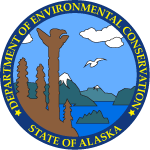| Action Date |
Action |
Description |
DEC Staff |
| 8/7/2007 |
Site Added to Database |
Site added to the database. |
Mitzi Read |
| 10/23/2008 |
Exposure Tracking Model Ranking |
Initial ranking with ETM completed for source area id: 75429 name: IHS Kanakanak Hospital - Area 3 |
Kim DeRuyter |
| 1/8/2009 |
Document, Report, or Work plan Review - other |
Site Characterization workplan approved. Three downgradient monitoring wells will be installed in summer '09. |
Kim DeRuyter |
| 5/22/2014 |
Update or Other Action |
Kanakanak Hospital UVOST Soil Characterization Work Plan submitted. The work plan proposes using Laser Induced Fluorescence/Utltraviolet Optical Screening Tool (LIF/UVOST) screening methods for soil characterization of Areas 3, 4, 8, 9, and 11 at the Kanakanak Hospital site. |
Meredith Savage |
| 2/9/2015 |
Update or Other Action |
Received two reports for review: Kanakanak Hospital Dental Clinic and Administrative Offices Vapor Intrusion Mitigation Design, and Contaminated Soil Materials Management Plan. |
Meredith Savage |
| 4/1/2015 |
Document, Report, or Work plan Review - other |
The Alaska Department of Environmental Conservation (ADEC) received a report titled Contaminated Soil Materials Management Plan, Dental Clinic and Administrative Offices on April 1, 2015. The report provides details on how excavated soil will be handled during construction of the Kanakanak Dental Clinic and Administrative offices. The clinic will be constructed within Area 3 of the hospital complex, a known area of petroleum hydrocarbon contaminated soils. Although extensive remediation has occurred within this area, contamination remains within the groundwater smear zone. To address the potential for encountering contaminated soils and to help ensure that unacceptable exposure does not occur during construction, all excavation activities will be monitored for signs of soil contamination, excavated soil will be field screened, and potentially contaminated soil will be stockpiled. A multi-incremental sample will be collected from the base of the excavation to document any potential residual contamination; the sample will be analyzed for diesel range organics (DRO), residual range organics (RRO), gasoline range organics (GRO), polycyclic aromatic hydrocarbons (PAH), and benzene, toluene, ethylbenzene, and xylenes (BTEX). Samples will also be taken from the stockpiled soil and any contaminated soil will be landfarmed onsite within the remedial treatment area (RTA) or an alternative onsite location if the RTA is not available. |
Meredith Savage |
| 4/17/2015 |
Document, Report, or Work plan Review - other |
The Alaska Department of Environmental Conservation (ADEC) received a report titled Vapor Intrusion Mitigation Design, Dental Clinic and Administrative Offices on April 7, 2015. The report describes the measures being taken to address the potential for vapor intrusion migration into the new dental clinic and administrative offices building proposed for construction in 2015. The building is to be constructed within Area 3 of the Kanakanak Hospital campus, an area known to have petroleum contamination remaining in the soil-groundwater interface zone. An earlier report dealt with management of any contaminated soils encountered during excavation of the building foundation. This report details the five design factors being used to mitigate the potential for vapor intrusion into the new building: placement of a subsurface vapor barrier, placement of structural fill, installation of a vapor venting, sub-building depressurization system, use of mechanical mitigation measures such a building pressure differentials, and the monitoring of crawlspace air and near foundation soil gas. Following installation and set-up of the vapor intrusion mitigation system it will be tested and monitored to maintain proper system operation and to verify that the remedial action objectives for the building are being achieved. |
Meredith Savage |
| 4/23/2015 |
Exposure Tracking Model Ranking |
A new updated ranking with ETM has been completed for source area 75429 IHS Kanakanak Hospital - Area 3. |
Meredith Savage |
| 5/14/2015 |
Cleanup Complete Determination Issued |
DEC has issued a determination of Cleanup Complete with Institutional Controls (ICs) for Area 3 of the Kanakanak Hospital Complex. No further remedial action will be required for Area 3 as long as compliance with the IC conditions is maintained. |
Meredith Savage |
| 8/7/2015 |
Update or Other Action |
Transferred to Fairbanks |
Susan Carberry |
| 8/13/2015 |
Site Visit |
Conducted site investigation of Areas 3, 5, 10, and 12 and all monitoring wells. Work at Areas 3 and 12 is going according to plan. Area 10 remedial treatment area (RTA) has completed 8 tilling events according to the work plan but additional tilling events will be required because soil has not yet reached alternative cleanup levels (ACLs). Area 5 excavation has contaminated soil that needs to be excavated, but the area is too wet for equipment due to consistent flow of water from building footer drain. Drain should be diverted, which will hopefully allow water to subside and excavation activities to continue. |
Joy Whitsel |
| 2/2/2016 |
Institutional Control Update |
DEC approved the final report titled "Dental Clinic and Administration Offices Cleanup Report." The report describes how excavated soil was handled during construction of the Kanakanak Dental Clinic and Administrative offices, in accordance with agreed upon Institutional Controls. Contaminated soil was segregated from clean soil based on field screening and was either placed in Area 10 Remediation Treatment Area (RTA) for landfarming or was stockpiled in Area 12 for landfarming within 24 months of excavation. Clean material (i.e., soil with in-situ PID readings < 20 ppm) was placed in a stockpile to the south of the parking lot south of Area 11, or in a stockpile to the south of Area 10. Multi-incremental sampling was conducted to assess soil contaminant levels remaining at the base of the excavation, and results for all analytes were below Alternative Cleanup Levels established for the site. |
Joy Whitsel |
| 10/19/2016 |
Site Characterization Workplan Approved |
DEC approved the Kanakanak Hospital Monitoring Work Plan. The work plan describes monitoring to be conducted on the Dental Clinic and Administrative Office (DAO) footer drain, the Building 401 footer drain, vapor intrusion system performance monitoring of the DAO, and multi-increment sampling from the Remediation Treatment Area at the Kanakanak Hospital campus in Dillingham, Alaska. |
Joy Whitsel |
| 9/28/2017 |
Site Visit |
DEC conducted a site visit of Kanakanak Hospital, focusing on the vapor mitigation measures taken at the DAO (Area 3), regrading of Area 5 and cleaning of the oil water separator, construction of the Area 6 landfarm, the adjacent Area 12 landfarm, and the Area 10 landfarm. A trip report documenting observations recorded during the site visit was provided to IHS and BBAHC. In general, all work was proceeding according to the applicable work plans and was protective of human health and the environment. One exception was the lack of berms present around the Area 10 landfarm to prevent runoff of contaminated soil. A letter was sent to IHS requesting corrective action. |
Joy Whitsel |
| 10/4/2017 |
Institutional Control Periodic Reporting |
Provided results of 2016 vapor intrusion monitoring. No contaminants of concern were above benchmark levels. |
Joy Whitsel |
| 8/2/2018 |
Document, Report, or Work plan Review - other |
DEC approved the 2016 Fall Kanakanak Hospital Monitoring Report, dated July 23, 2018. The report describes monitoring activities at Area 5 (monitoring the footer drain from Building 401), Area 3 (vapor intrusion system performance monitoring for the Dental and Administrative Offices), and Area 10 (multi-incremental sampling at the landfarm). The 2016 report recommends the Oil-Water Separator be cleaned to prevent sediment from accumulating in the Bldg 401 footer drain. Vapor intrusion results from the Dental and Administrative Offices (DAO) were below the commercial indoor air target levels for volatile organic compounds (VOCs). Multi-incremental results at Area 10 indicated the fifth layer of contaminated soil has been treated to contaminant levels below the alternate cleanup level for diesel range organics (DRO). Concentrations still remain above 18 AAC 75 Table B2 values. Monitoring of these areas is expected to continue. |
Erica Blake |
| 8/2/2018 |
Document, Report, or Work plan Review - other |
DEC approved the February 2018 Kanakanak Hospital Monitoring Report, dated July 23, 2018. The report describes activities conducted on October 17, 2017 and February 6-12, 2018. Activities conducted on October 17, 2017 included collecting one analytical sample from the footer drain of the main hospital building (Building 401). Activities conducted February 6-12, 2018 included; soil removal and sample collection from Area 5, baseline multi-incremental sampling from Area 6 and Area 10, analytical groundwater sampling from monitoring wells around the hospital building, collecting indoor air samples from the Dental and Administrative Offices (DAO) building (Area 3), collecting a soil gas sample from the vapor monitoring point south of the DAO building, and collecting an analytical sample from the outfall of the oil-water separator (OWS) for physical and chemical parameter analysis. Monitoring at these areas is expected to continue. |
Erica Blake |
| 5/8/2020 |
Update or Other Action |
DEC conducted a teleconference with IHS, BBAHC, and ERM representatives for the site. Discussed summary of site. Additionally, clarified that the Alternative Cleanup Levels (ACLs) from 1998 would no longer apply as regulations have been introduced that are more stringent than these values. DEC will send a formal letter explaining the decision to rescind old cleanup levels and clarifying applications of newer levels as detailed in 18 AAC 75.340 and 345. |
Tim Sharp |
| 7/21/2020 |
Update or Other Action |
Due to numerous regulatory changes, updated toxicological information, and groundwater impacts at the site, the 1998 ACLs previously accepted by DEC have been rescinded. The contaminated sites at Kanakanak Hospital are subject to the “site cleanup rules”, 18 AAC 75.325 – 18 AAC 75.390. Thus, in lieu of the 1998 ACLs, the currently promulgated cleanup levels in 18 AAC 75 apply. For contaminants in soil, the Human Health, Maximum Allowable, and Migration to Groundwater cleanup levels apply, as listed in Tables B1 and B2 of 18 AAC 75.341. For contaminants in groundwater, the Groundwater Cleanup Levels in Table C of 18 AAC 74.345 apply. Sites that were previously categorized as 'Cleanup Complete' or 'Cleanup Complete with Institutional Controls' may be subject to further review. DEC has sent a formal letter to IHS and BBAHC representatives explaining this change. |
Tim Sharp |
| 8/17/2020 |
Document, Report, or Work plan Review - other |
DEC supplied comments for the Site Wide IC Management Plan. The IC MP details the history of each area of concern at the site and the specific ICs in place for each of the closed sites with ICs. Due to the rescission of the 1998 ACLs, DEC requested each AOC be analyzed by IHS to determine if the ICs are still protective of human health and the environment. Other comments call attention to potentially complete pathways to consider, and further monitoring of groundwater at landfarms. |
Tim Sharp |
| 9/21/2020 |
Update or Other Action |
DEC received the Draft Plan to Develop ACLs at Kanakanak Hospital Memo. The RP has chosen to use the hydrocarbon risk calculator to develop new ACLs. The methods listed include using previous data for Toc values, while collecting new samples for EPH/VPH analysis. Conservative values will be used for bulk density, aquifer thickness, and porosity. A list of data gaps involving drill rig mobilization is also included. |
Tim Sharp |
| 10/23/2020 |
Document, Report, or Work plan Review - other |
DEC provided comments for the Draft Plan to Develop ACLs Memo. Comments regarded including figures for sampling locations, methodology clarification, and bringing attention to data gaps that would require a drill rig to close (Area 3 and 7 MAC exceedances). |
Tim Sharp |
| 5/4/2022 |
Site Characterization Workplan Approved |
DEC Accepted the Final Kanakanak Supplemental Site Investigation Work Plan. Soil and groundwater samples will be collected at eight areas of concern (AOCs), which will be used to assist in characterizing contamination at the site, as well as developing site-specific alternative cleanup levels (ACLs). |
Tim Sharp |
| 7/19/2022 |
Site Visit |
DEC performed a site visit for all areas of concern on the Kanakanak Hospital campus. As part of the site visit, IHS, BBAHC, ERM and DEC held a meeting to discuss the proposed next steps at the site to evaluate remaining contamination and potential transfer of property from IHS to BBAHC. |
Tim Sharp |
| 1/3/2023 |
Document, Report, or Work plan Review - other |
DEC reviewed and submitted comments for the Proposed Alternative Cleanup Levels Memo for Kanakanak Hospital. The Memo proposes new alternative cleanup levels (ACLs) intended to be protective of human health, safety, welfare, and the environment for “residential land use” as described in 18 AAC 75.990. ACLs were developed using the Hydrocarbon Risk Calculator (HRC) as allowed under 18 AAC 75.340 (d) – (f). The ACLs were established to reflect fate and transport properties, toxicity characteristics, and potential exposure routes of contaminants at the site. Diesel range organics (DRO), benzene, ethylbenzene, ethylene glycol, naphthalene, tetrachloroethene, 1,2,3-trichlorobenzene, and 1-methylnaphthalene all have new proposed ACLs given the three- and four-phase calculations conducted using new and historical site-specific data. |
Tim Sharp |
| 3/24/2023 |
Document, Report, or Work plan Review - other |
DEC approved the Proposed Preliminary Remediation Goals (PRGs) based on Hydrocarbon Risk Calculator (HRC) Calculations Tech Memo for Kanakanak Hospital in Dillingham. The tech memo proposes new PRGs intended to be protective of human health, safety, welfare, and the environment for “residential land use” as described in 18 AAC 75.990. PRGs were developed using the HRC. The PRGs were established to reflect fate and transport properties, toxicity characteristics, and potential exposure routes of contaminants at the site. Diesel range organics (DRO), benzene, ethylbenzene, ethylene glycol, naphthalene, tetrachloroethene, 1,2,3-trichlorobenzene, and 1-methylnaphthalene all have new proposed PRGs given the three- and four-phase calculations conducted using new and historical site-specific data.
The technical memorandum asserts that the results of the HRC require validation. Upon attaining PRGs in soil at a given area of concern, model validation will be considered complete when measured concentrations in groundwater fall below 18 AAC 75.345(b), Table C groundwater cleanup values in at least two successive sampling events, accounting for seasonal variability. If these values cannot be attained, reassessment of the PRGs may be appropriate to adjust them downwards.
|
Tim Sharp |
| 8/25/2023 |
Document, Report, or Work plan Review - other |
DEC completed a review of the Draft Supplemental Site Investigation Report. The SI Report details soil and groundwater sampling at eight areas of concern (AOCs) at the Indian Health Service (IHS) Kanakanak Hospital Site. These samples are being used to assist in characterizing contamination at the site, and are being evaluated in tandem with the recent preliminary remediation goals (PRGs) identified in the Proposed Preliminary Remediation Goals based on Hydrocarbon Risk Calculator Calculations memorandum, approved by DEC. Future review of previously closed sites is recommended, and a feasibility study will be prepared for evaluation of remediation options. |
Tim Sharp |




